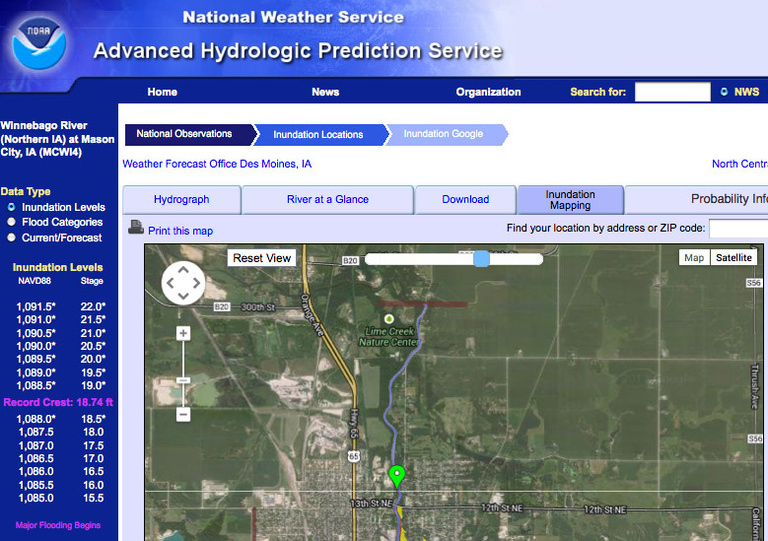A dynamic, new online flood preparedness tool which will help emergency managers improve flood warnings and response has been developed for the Winnebago River at Mason City, Iowa.

Because this new tool is so critical during floods, it is available from two sources. The first source is the National Weather Center Advanced Hydrologic Prediction Service (AHPS) website. On the AHPS page for the Winnebago River at Mason City, click on the tab near the top of the page named “Inundation Mapping.” The second source is the Iowa Flood Center’s Iowa Flood Information System (IFIS). Go to the Flood Maps section on the right hand side of the page and select Mason City.
The National Weather Service (NWS) collaborated with the Iowa Flood Center (IFC) to develop a library of flood inundation maps. The final version of these flood inundation maps is the culmination of a partnership between the IFC, the Cerro Gordo County Emergency Management Agency, the NOAA Central Region-Regional Collaboration Team, and the NWS. This capability will help communicate the residual flood risks for areas behind the city’s levee and the additional flooding from Willow Creek, a tributary to the Winnebago River.
To read a related story, visit Flood center projects benefit Iowa.

Flood inundation maps help people visualize the potential extent of flooding at various river levels. This information can assist in planning and mitigation decisions.
Nathan Young, associate director of the Iowa Flood Center, says the IFC has been developing flood inundation maps since its inception in 2009.
“This is an opportunity for us to apply research that is useful and meaningful for Iowans,” he says. “These detailed maps demonstrate the extent of the flooded landscape with every 12 inch rise in the flood level. We believe this information will empower communities and individuals to make informed decisions about their flood risks.”
Jeff Zogg, senior hydrologist for the National Weather Service in Des Moines, says the development of the Mason City flood inundation maps was a team effort, which resulted in valuable tools for people in the Mason City area.
“Many people worked together to make these maps available," Zogg says. "We especially appreciate the involvement of emergency management and public works officials in the Mason City area. These maps will help the NWS provide enhanced decision support services to people there.”
Steve O’Neil, director of the Cerro Gordo County Emergency Management Agency says that the flood inundation maps will be valuable for multiple reasons.
“The flood inundation maps will be a great asset for Cerro Gordo County Emergency Management for long range planning for our communities," O'Neil says. "They will also be invaluable for risk management decisions to anticipate possible trouble areas early on in flood incidents, which will allow us to make sound decisions regarding evacuations or locations for defensive flood fight tactics. Overall a very useful tool for the emergency management toolbox.”
The National Weather Service is the primary source of weather data, forecasts, and warnings for the United States and its territories. The National Weather Service operates the most advanced weather and flood warning and forecast system in the world, helping to protect lives and property and to enhance the national economy. The NWS provides decision support services as well as enhanced services to local, state, and regional decision makers. For other locations where flood inundation maps are available, see the NWS AHPS website.
The Iowa Flood Center is part of IIHR—Hydroscience & Engineering, a research institute based at the UI’s College of Engineering. The IFC provides accurate, state-of-the-science-based information to help Iowans better understand their flood risks. It is the nation’s first academic center devoted solely to the study of floods. Additional IFC resources—including flood inundation maps for other Iowa communities—can be found on the IFC website.
The Cerro Gordo County Emergency Management Agency provides for the protection of life and property by assisting its citizens to prepare for, respond to, recover from, and prevent or reduce the effects of a disaster—whether it is natural or manmade. More information about the Cerro Gordo County Emergency Management Agency is available on its website.
The Mason City flood inundation maps are based on observations and forecasts involving readings from the U.S. Geological Survey (USGS) stream gage along the Winnebago River at Mason City. More information about USGS stream gaging in Iowa is available on the USGS Iowa Water Science Center website.